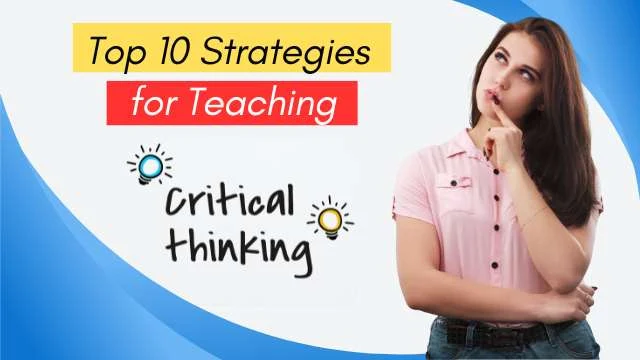Acquiring critical thinking skills is imperative for individuals to achieve success both in their academic pursuits and professional endeavors. It empowers individuals to scrutinize and assess information critically, resolve problems, and arrive at sound decisions based on informed judgment. However, teaching critical thinking is not an easy task.
To develop the analytical and problem-solving skills of students, it is essential to employ effective strategies deliberately and consistently put in efforts towards their implementation. In this blog post, we will explore some effective strategies for teaching critical thinking that teachers can use to foster their students' intellectual abilities.
Introduction to Critical Thinking
Critical thinking involves the capability to evaluate information systematically, independently, and with a discerning mindset to make informed decisions and conclusions. It involves analyzing information, recognizing patterns, and identifying biases to solve problems and make decisions. Critical thinking is not just limited to academics; it is a skill that is required in everyday life situations, such as decision-making, problem-solving, and effective communication.
10 Effective Strategies for Teaching Critical Thinking
1. Encourage Curiosity
Curiosity is the foundation of critical thinking. Promoting the habit of inquisitiveness and encouraging students to explore various perspectives can aid in the development of their critical thinking skills. Teachers can promote curiosity by posing open-ended questions, encouraging students to research, and facilitating class discussions that promote critical thinking.
2. Teach the Art of Questioning
Proficiency in asking relevant questions is a crucial aspect of critical thinking. Teachers can teach students the art of posing questions that stimulate analytical and evaluative thinking. For example, asking open-ended questions, prompting students to clarify their ideas, and asking them to evaluate the evidence they have collected can help develop their critical thinking skills.
3. Develop Metacognition
Metacognition entails the capacity to reflect on one's own thinking process. Teachers can foster metacognitive abilities in students by teaching them how to introspect and assess their learning process. For example, students can evaluate their understanding of a concept, identify their strengths and weaknesses, and develop strategies for improving their learning.
4. Encourage Analytical Reading
Analytical reading involves actively engaging with the text to understand its meaning, structure, and purpose. Teachers can encourage analytical reading by teaching students to identify the main ideas, arguments, and evidence presented in the text. They can also teach students to evaluate the credibility of the author, consider alternative perspectives, and develop their own interpretations.
5. Promote Collaborative Learning
Collaborative learning involves working with others to achieve a common goal. It can help develop critical thinking skills by exposing students to different perspectives, encouraging them to consider alternative solutions, and teaching them to communicate effectively. Teachers can promote collaborative learning by assigning group projects, facilitating class discussions, and encouraging peer review.
6. Use Real-Life Scenarios
Using real-life scenarios can help students understand how critical thinking can be applied in real-life situations. Teachers can use case studies, role-playing, and problem-solving activities to engage students in critical thinking. These activities can help students develop their problem-solving skills, analyze complex situations, and make informed decisions.
7. Teach Information Literacy
Information literacy is the capability to effectively obtain, evaluate, and employ information to achieve one's objectives. In today's digital age, it is more important than ever to teach students how to evaluate information critically. Teachers can teach information literacy by helping students identify credible sources, evaluate the accuracy and reliability of information, and recognize bias.
8. Develop Creativity
Encouraging creativity can help students develop their critical thinking skills. Teachers can encourage creativity by assigning open-ended projects that allow students to explore different approaches, and develop their own solutions. Creative thinking can help students develop their problem-solving skills, think outside the box, and explore alternative solutions.
9. Foster a Growth Mindset
Developing a growth mindset can help students develop their critical thinking skills. Teachers can foster a growth mindset by encouraging students to embrace challenges, view failures as opportunities to learn, and develop resilience. A growth mindset can help students develop a positive attitude towards learning, explore new approaches, and develop their analytical skills.
10. Use Technology
Technology can be a powerful tool for teaching critical thinking skills. Teachers can use technology to facilitate collaborative learning, present real-life scenarios, and engage students in interactive learning activities. Technology can also provide access to a wealth of information, and teachers can teach students how to evaluate and analyze the credibility and reliability of online sources.
Conclusion
Teaching critical thinking is a critical part of education. It is a skill that can help students excel academically and professionally. By encouraging curiosity, developing metacognition, promoting collaborative learning, and using real-life scenarios, teachers can help students develop their analytical and problem-solving skills. As teachers, it is important to integrate critical thinking into every aspect of our teaching and help students become independent thinkers who can make informed decisions and solve complex problems.
